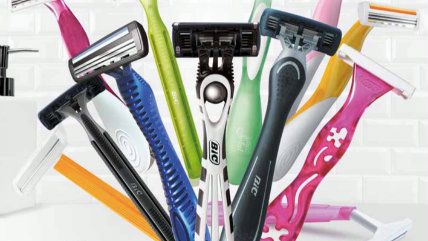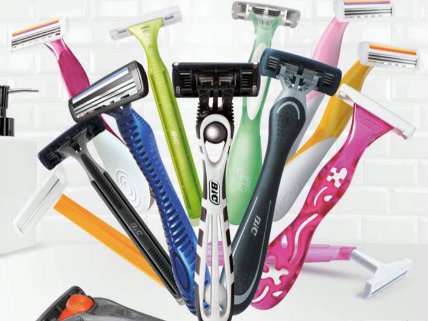The 'Pink Tax' Is a Myth
Is the "pink tax" a corporate conspiracy, patriarchy in action, or just market preferences at work?


During the height of holiday shopping season, a consumer report stoked ample ill-will toward American manufacturers after purporting to show that women's products are priced higher for completely arbitrary reasons. This so-called "pink tax," said the New York City Department of Consumer Affairs (DCA), affects almost every product marketed at American females, "from cradle to cane."
"The goal of the study was to estimate the price differences male and female shoppers face when buying the same types of items," the department states. It looked at 35 different product types, examining 794 individual items from 91 different brands.
"On average, DCA found that women's products cost 7 percent more than similar products for men," the department concluded. The biggest price differentials were found for personal-care products (13 percent), adult clothing (8 percent), and home health care products (8 percent). The DCA refers to this impact as a "gender tax."
Though DCA acknowledges that "there may be legitimate drivers behind some portion of the price discrepancies," it still seems to consider this an unfair situation. Sure, women's products frequently contain different ingredients than do men's. But "individual consumers do not have control over the textiles or ingredients used in the products marketed to them and must make purchasing choices based only on what is available in the marketplace," the report notes.
Of course, individual consumers do have control over which products they buy, though. And while the pink razors with the butterflies on the packaging my be marketed toward women, no one's forcing us to buy those over basic blue Bics. If the products in this study really were identical save for some totally non-desired factors, it seems likely that women, or at least a larger proportion of women, would simply choose the products marketed toward men.
Since they don't, one can jump to one of two conclusions: either women are so brainwashed by marketing that they choose products against their own best interests because of it, or women find some discernible appeal in the women's products—be that different ingredients, cosmetic factors, or whatever else—that make them worth paying more for. I'm going to go with the explanation that grants women a little intelligence and agency.
Many people, however, opted for the former explanation. And while a few outlets focused on consumer choice, highlighting how women should go with men's products where they can, more went the "Ladies, prepare to be outraged" route. "That face wash you're holding in your hand is most likely a marked up version of an identical men's product" (emphasis mine) said millennial women's site Bustle. "Pretty much everything we women buy costs more than a man pays," lamented The Stir. And Femsplain described "the insidious gendered pricing" as a "cornerstone of toxic masculinity."
Think it's just women's media? "As if sexism, discrimination, and a 21 percent wage gap weren't infuriating enough, a new study reaffirms that being a woman is just flatly more expensive," starts a story at Vocativ. "Ever heard of the 'pink tax'?" asks Upworthy. "It's real and cutting into women's finances in a big way." The New York Times editorial board even floats the idea of "legislative relief" from the "gender tax.
Alas, this sillier yet more regulation-friendly narrative has also been embraced by government officials. Because if manufacturers can use gender to turn a profit, why can't the government use feminism for its own aims and gains? "Women should not have to pay more than men for our everyday items," DCA Commissioner Julie Menin told Broadly. "Combating gender pricing is a key issue in the fight against inequality in our country."



Show Comments (164)